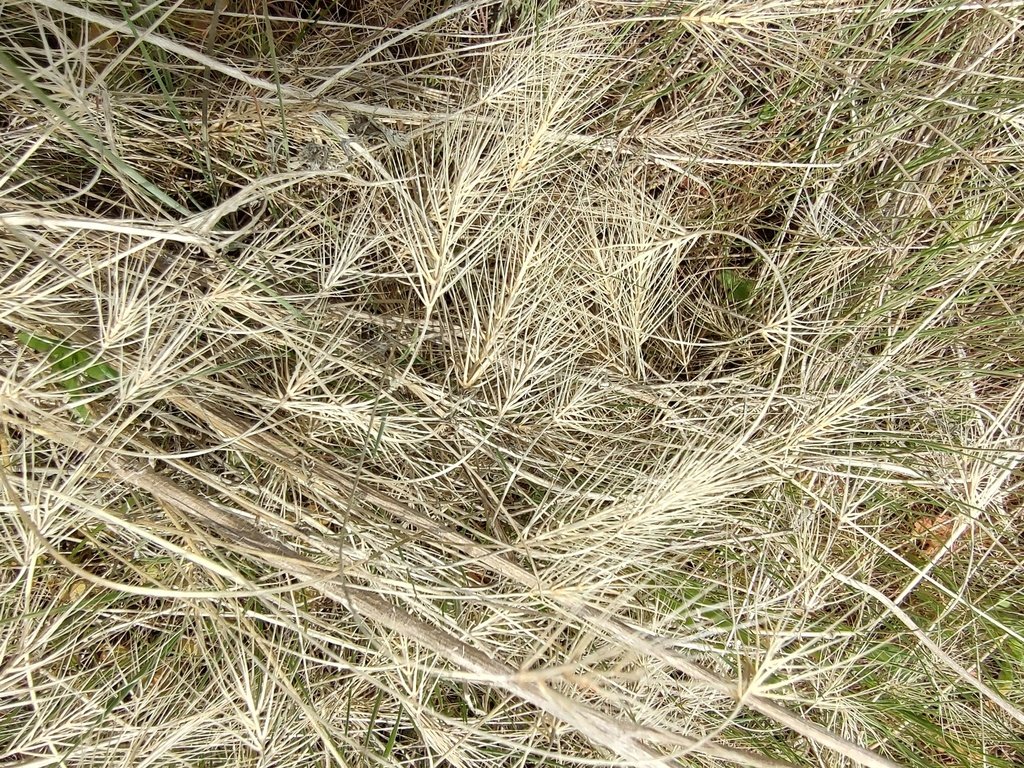Medusahead May(hem)!
Every spring, infamously known as “medusahead May” by Grassroots Ecology staff, we head off-trail at Pearson-Arastradero Preserve to monitor, map, and remove an invasive annual grass called medusahead (Taeniatherum caput-medusae or Elymus caput-medusae). Grassroots Ecology has been actively managing medusahead here since 2010 to prevent it from spreading throughout the preserve and into the adjacent Foothills Nature Preserve. If left unchecked, medusahead can quickly form dense and highly flammable monocultures that suppress native species and increase fire risk.
Who is she?
Medusa is a gorgon from Greek mythology known for having snakes for hair and eyes that turn mortals to stone! Her iconic legacy is now memorialized in this grass called medusahead. When the seedheads fully dry out, the awns (bristles growing from flowers or seedheads) twist and curl, resembling Medusa and her snake hair—earning this grass its formidable name.
Medusahead’s native range extends from Central Europe to North Africa and the Mediterranean, as far east as Pakistan. It is adapted to a climate similar to California—hot dry summers and cool wet winters—allowing it to thrive in California, where it has become an invasive species of concern. It was first introduced to Oregon as an agriculture seed contaminant around 1887, and reached the Sacramento Valley of California by 1900. Since then, it has been spreading throughout the west, becoming especially widespread in the grasslands and scrublands of the Great Basin region.
Medusahead matures a couple of weeks to over a month later than most other annual species. By spring to early summer, most annual plant species have senesced and dropped their seed. However, the immature seedheads of medusahead are still ripening, so it looks like a little green patch in a sea of yellow and brown.
Medusahead in its native range.
Why is management a priority?
One of many invasive annual grasses, medusahead is rated high risk by the California Invasive Plant Council. It is widespread, has high rates of germination, dispersal and establishment, and has severe impacts on ecosystem functioning. It is rapidly expanding throughout the West, increasing wildfire risk and outcompeting native species.
Medusahead Ecology
Medusahead is an excellent survivor. It competes with other species for water and nutrients, and can reach soil water at depths where some native grass roots grow. Medusahead germination rates are very high, and like other annual grasses, it produces a high number of seeds every year. The seedbank only persists for about 2 years, with very little surviving 3 or more years.
Dried medusahead forms a dense thatch.
Medusahead seeds are spread by the wind, and by latching on to the coats of livestock and wildlife with its twisted snake-like awns (which also have tiny barbs on them). Seeds can also be spread and dispersed by attaching to machinery, vehicles, and clothing. It can spread in undisturbed areas, but does especially well in disturbed areas already impacted by overgrazing, mechanical disturbance (tilling, mining, etc), wildfire, or farming.
Unlike most other plants, medusahead has a high silica content. After it drops its seeds and dries out for the year, thick layers of thatch are left behind, which build up and take much longer to decompose than other plants. Only medusahead is able to germinate through the thatch build up, excluding other species. This persistent thatch retains soil nutrients, delaying and altering nutrient cycling, and creates excess dry fuel, posing a fire danger.
Unfortunately, medusahead is not very palatable by wildlife and livestock because of the long awns, barbs, and its high silica content. As a result, this noxious weed does not provide much food for other species. It is dangerous to rangelands throughout the intermountain west, as it reduces grazing capacity by as much as 50%. When they mature later in the season, the long-awned seeds can injure foraging animals.
With all these factors taken into account, medusahead is a real threat to grasslands and shrublands around the west. Once it is established, and without management, it will spread very rapidly, forming dense monocultures that inhibit plant diversity. This, of course, has ripple effects to all other species that use and need grassland for their survival.
How We Manage Medusahead
In the 15 years since medusahead was detected at Pearson-Arastradero preserve, we have developed an action plan for managing this invasive grass. Our strategy is: Scout, map, mow!
Scout
Staff walk the preserve in May to June searching for medusahead, focusing on areas previously mapped with historical and/or known occurrences. We sweep through the area by walking in lines standing around 5 feet apart scanning for the grasses. You may think it’s like looking for a needle in a haystack, but since medusahead stays green much later than other annual grasses, it’s not as hard to spot as you may think.
We usually stumble upon lots of beautiful things too, like wildflowers and wildlife.
Found while searching for medusahead: a crab spider eats a skipper on white brodiaea.
Map
When we find medusahead individuals or dense patches, we record the location, size of the population, year, and other data with an app called Calflora. Then we mark the center of the population with a PVC pipe and a flag so we can find it and mow it. You may have seen some of these markers while hiking around at Arastradero!
Left: mapping a medusa population; right: a population marked with a flag.
Mow
Mowing happens in late spring during the early flowering state when seeds have not matured. This way, the seeds are not viable and it’s too late for the grass to resprout and flower again. We have found that the second and third weeks of May are the ideal times to mow, before seeds are mature. We mow a 3 meter circle around our PVC stakes using weed wackers, to ensure that we get the entire population and any stragglers nearby. Weed wackers are easy to transport and enable us to mow hard to reach populations on steep inclines or other hard to reach areas. For large populations, we mow larger circles as needed, and create mow maps identifying target areas for City of Palo Alto Rangers to mow with a tractor.
(From left) Grassroots Ecology’s Serena Myjer and Hannah Cunningham weed wacking medusahead; the grass during the “soft dough” or “milky” stage, its ideal mowing time; members of the San Jose Conservation Corps targeting medusahead populations.
We work with the San Jose Conservation Corps to ensure we reach all of the scouted population points. Over the course of 3 work days at Arastradero, the Corps mowed over 100 population points. Our strategy relies on our partnerships with the City of Palo Alto and the San Jose Conservation Corps, as well as funding from the California State Coastal Conservancy’s Wildfire Resilience Program.
Holding the Line Against Medusahead
Since we began managing medusahead at Arastradero Preserve in 2010, we’ve been successful in reducing its spread. Although we find some new patches every season, we also remove flags every season, and have contained the spread to certain areas of the preserve. And, there are no large monocultures or fields completely taken over by the plant, which is what happens without management.
Grassroots Ecology staff searching for medusahead.
We recognize that there will always be factors outside our control, which is why stewarding large preserves like Arastradero requires dedication and perseverance. One of Grassroots Ecology’s strengths is our commitment, year after year, to invasive plant management as an essential part of habitat restoration.
What To Do If You Find Medusahead
You can help prevent the spread of medusahead and other invasive plants by making sure you aren’t carrying any seeds with you around a site or to a new place. Avoid walking through heavily infested areas, and check your clothes and shoes for stray seeds after hiking.
If you come across a small population, hand pull it. Check if the seeds are mature, in which case you should bag and dispose of all medusahead plants.
Left: a mature seed head (or “skeleton”) dropping its seeds; right: mature seed head with awns turning purple. If you find medusahead that looks like these individuals, it should be removed, bagged, and disposed of!
For large populations that cannot be reasonably hand pulled, you can try our mowing method. Alternative management techniques include tillage, chemical control, or prescribed fire. Each technique has its own advantages and disadvantages that should be considered before applying over a large area. We find that mowing works for us without the need for herbicides or large equipment. You can learn more about best practices for medusahead management on the California Invasive Plant Council website.
If you find plants that already went to seed, like dried seed heads or “skeletons,” it is best to remove the thatch build up by raking and bagging the plants, so other plants can establish. Last but not least, record the location where you found it with a tool like Calflora or iNaturalist, so you can come back next spring to weed—and to alert ecologists and land managers to the population. Every patch and every plant helps!
By Serena Myjer, Restoration Specialist











